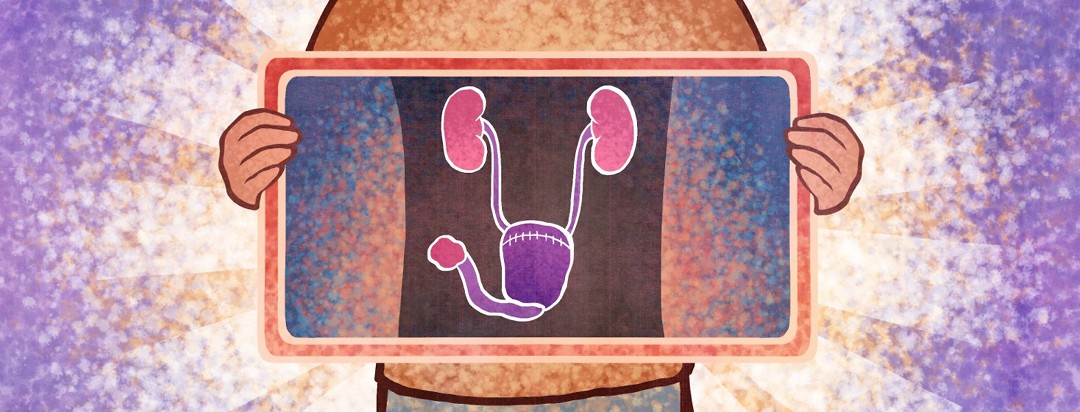Meet Jeri & Learn About Life With an Indiana Pouch
Those who undergo bladder removal surgery (a radical cystectomy) to treat their bladder cancer are faced with another decision: which type of urinary diversion should they choose? From the ileal conduit (IC) to the Indiana Pouch (IP) to the neobladder (NB), the choice is personal and impactful.
How common is each type of urinary diversion?
One study looked at radical cystectomy cases at Indiana University from 2011 to 2013 and found that out of 233 people, about 60 percent opted for the IC, 24 percent for the NB, and 16 percent for the IP.1 These results suggest that the Indiana Pouch is the least common type of reconstructive surgery but we know many of our BladderCancer.net community members elect this type of urinary diversion. We decided to interview one such member who lives with the Indiana Pouch, Jeri Bachli, PhD. Read on to learn about her story and experiences!
What is the Indiana Pouch?
The Indiana Pouch is also known as a continent diversion. The surgeon creates a pouch out of a small part of the person’s own intestines to store urine inside the body. The person empties that pouch every 4-6 hours using a catheter (a thin, flexible tube) that is inserted through the stoma (a small opening in the patient’s abdomen).2
Meet Jeri and learn why she chose the Indiana Pouch
BladderCancer.net Editorial team member Alina Ahsan connected with Jeri to ask her about her bladder cancer journey. Check out the interview below!
Diagnosis
Alina: Tell us about your bladder cancer diagnosis and the treatments that were recommended.
Jeri: At age 57, blood showed up in my urine during a regular OB/GYN check-up. I was told it was the result of smoking for 20 years. I got a referral to a urologist, and a biopsy of bladder tissue determined the diagnosis of bladder cancer. Dr. Libertino at Leahy Clinic operated for 8 hours. I had a complete hysterectomy, bladder removal, partial vaginal tissue removal, and an appendix removal so that valve could be used. Radiation or chemotherapy were not needed.
Choosing the Indiana Pouch
Alina: How did you choose to have an Indiana Pouch instead of the ileal conduit or the neobladder? How did your doctor explain the differences?
Jeri: Vanity. Body Image. I thought myself still a “hottie” at age 57. My doctor explained the differences between the types of diversions, but I wasn’t listening much after he said no one would know if I chose the Indiana Pouch – that was the deciding factor.
A day in the life
Alina: What is a normal day like with the Indiana Pouch? What has changed since your bladder removal surgery and how have you adapted?
Jeri: A normal day is to get up, use a catheter and irrigate, and then use catheter every 4 hours until bedtime when again - catheter and irrigate. The pouch was never continent, so I use Coloplast wafers and pouches, the kind that can be disconnected to the catheter. This brand is highly recommended by me after trying other brands. A high-profile job made “accidents” very stressful. I learned to carry extra supplies and a pair of undies just in case.
Surgery recovery and work
Alina: How did you manage working through bladder cancer treatment and surgery recovery? How was life working after your surgery?
Jeri: At first, it was hard. I spent a lot of time in the bathroom. I used pink rubber catheters and never really knew if the bladder was empty. Later, I used clear plastic ones and could see when the white excretions from the bladder wall were blocking the “works.” I was also more careful when I took high blood pressure pills and the amount of coffee I drank in the morning. Everything affected the works. I brought nursing pads and extra panties to work. Sometimes, I had to go home to change, hiding the wet spots with my raincoat.
Diagnosed at a young age
Alina: What was it like being diagnosed at such a young age relative to the average age for a bladder cancer diagnosis?
Jeri: Of course, I was extremely surprised! However, I really did not realize the seriousness of it all. The operation and the almost three-month recovery changed all that. I had great support (one daughter is a nurse), and really good friends that kept me in good spirits and changed the bed every day at home. It was a long bump in the road, that’s all.
Winding down for the day
Alina: Thank you so much for sharing your perspective with us! One last question: What is your favorite way to unwind after a long day?
Jeri: A nap every day has become a necessity. To get into that relaxed state, I usually listen to a half or full-hour meditation free on YouTube. I highly recommend any meditation by the Reach Approach and the Mindful Movement. Evenings are not complete without The Wheel of Fortune, Jeopardy, and a movie. When I go to bed, I put earphones on and listen to lectures from the Great Courses. They’re like bedtime stories for adults.
Can you relate?
We are grateful that Jeri is a part of our community and that we can share her story with you. Which parts of Jeri’s journey could you relate to?

Join the conversation